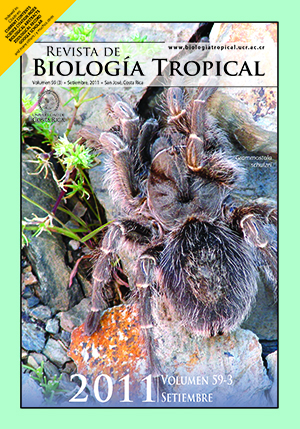Resumen
Forests structural differences could result of environmental variations at different scales. Because soils are an important component of plant's environment, it is possible that edaphic and structural variables are associated and that, in consequence, spatial autocorrelation occurs. This paper aims to answer two questions: (1) are structural and edaphic variables associated at local scale in a terra firme forest of Colombian Amazonia? and (2) are these variables regionalized at the scale of work? To answer these questions we analyzed the data of a 6ha plot established in a terra firme forest of the Amacayacu National Park. Structural variables included basal area and density of large trees (diameter=10cm) (Gdos and Ndos), basal area and density of understory individuals (diameter < 10cm) (Gsot and Nsot) and number of species of large trees (sp). Edaphic variables included were pH, organic matter, P, Mg, Ca, K, Al, sand, silt and clay. Structural and edaphic variables were reduced through a principal component analysis (PCA); then, the association between edaphic and structural components from PCA was evaluated by multiple regressions. The existence of regionalization of these variables was studied through isotropic variograms, and autocorrelated variables were spatially mapped. PCA found two significant components for structure, corresponding to the structure of large trees (G, Gdos, Ndos and sp) and of small trees (N, Nsot and Gsot), which explained 43.9% and 36.2% of total variance, respectively. Four components were identified for edaphic variables, which globally explained 81.9% of total variance and basically represent drainage and soil fertility. Regression analyses were significant (p < 0.05) and showed that the structure of both large and small trees is associated with greater sand contents and low soil fertility, though they explained a low proportion of total variability (R2 was 4.9% and 16.5% for the structure of large trees and small tress, respectively). Variables with spatial autocorrelation were the structure of small trees, Al, silt, and sand. Among them, Nsot and sand content showed similar patterns of spatial distribution inside the plot.##plugins.facebook.comentarios##

Esta obra está bajo una licencia internacional Creative Commons Atribución 4.0.
Derechos de autor 2011 Revista de Biología Tropical
Descargas
Los datos de descargas todavía no están disponibles.






